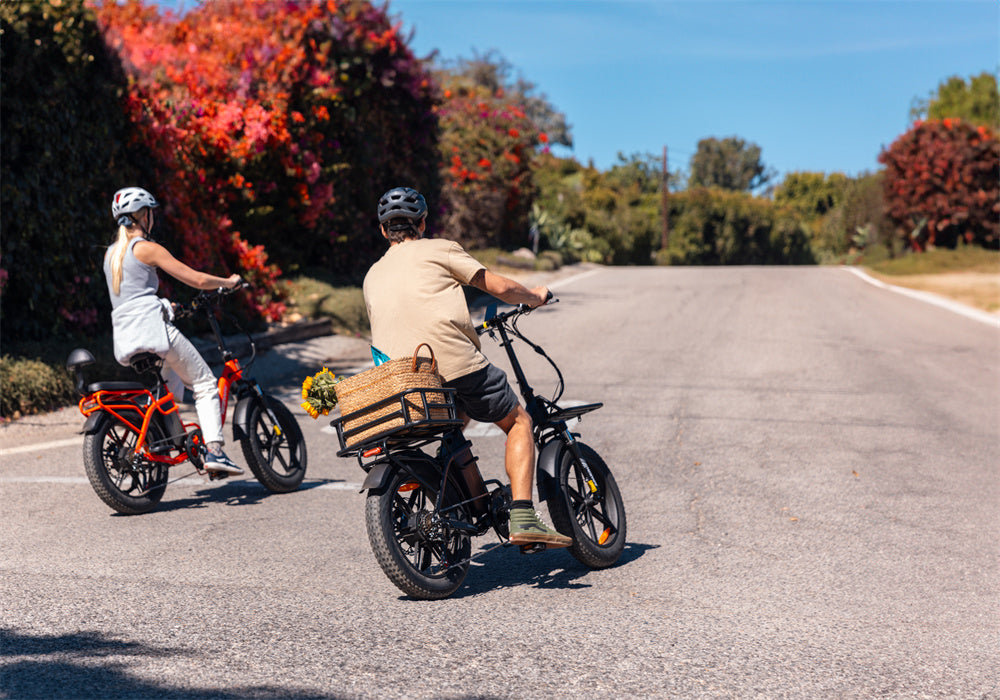Lubricating your bike chain is one of the most frequently discussed topics. The idea that you should lube your chain after every ride among cyclists.
However, this practice is not only unnecessary but can also be counterproductive if done too often.
In this article, we will explore why lubing your electric bike chain after every ride might not be the best approach and provide detailed guidance on how to properly maintain your chain.
How Do I Know If My Bike Chain Needs Lube
Recognizing when your bike chain needs lubrication is crucial for maintaining your bike’s performance and longevity. But how do you know when it's time to lube up?
Listen for Weird Noises
A well-lubricated chain should run quietly and smoothly. If you start hearing a grinding or squeaking sound when pedaling, it’s a clear indication that your chain is dry and needs lubrication.
The noise comes from the metal-on-metal contact between the chain and the drivetrain components, which can cause wear and tear over time.
Check How It Looks
Take a close look at your chain. A chain in need of lubrication will often appear dry, and you may notice dirt or grime clinging to the links. If your chain looks dry or rusted, it’s time to apply lube.
Conversely, a chain that is overly shiny or has excess lube dripping from it indicates that you've over-lubed, which can attract dirt and debris, leading to further issues.
Feel the Chain
After a ride, you can touch the chain to check its condition.
If the chain feels gritty or rough, it’s likely that the lube has worn off, and it’s time to reapply. A properly lubed chain should feel smooth but not oily.
How’s Your Ride
If you notice your bike isn’t shifting as smoothly as it should, or you feel extra resistance while pedaling, your chain might be too dry. In these cases, applying a fresh coat of lube can improve the performance and efficiency of your ride.

SEE ALSO How to Change Bike Brake Pads? (Mechanical and Hydraulic Disc Brakes)
After Every Ride I Should Lube the Chain
It's a common belief that you should lube your bike chain after every ride, but this isn't always necessary or even beneficial.
Lubing the chain after every ride can actually lead to an accumulation of excess lubricant, which attracts dirt and debris.
This buildup can cause more harm than good, leading to a grimy chain that wears out faster and reduces the efficiency of your bike's drivetrain.
The need to lube your chain depends on several factors, such as the conditions you ride in, the length of your rides, and the type of lubricant you use.
For example, if you ride in wet or muddy conditions, it might be necessary to clean and lube your chain more frequently to prevent rust and wear.
However, for typical dry-weather rides on clean roads, you likely won't need to lube your chain after every ride.
Instead of automatically lubing after every ride, it's better to inspect your chain regularly.
Look for signs of dryness, listen for squeaks or grinding noises, and feel the chain to determine if it needs more lube.
By being more selective and thoughtful about when to lube, you can extend the life of your chain and keep your bike running smoothly without overdoing it.

Do I Really Need Chain Lube
Chain lube is essential for any bike, but not all lubes are created equal, and the frequency of application can vary depending on several factors, including the type of lube, the conditions you ride in, and the type of bike you have.
Why Lube Matters
Chain lube reduces friction between the moving parts of your drivetrain, which helps prevent wear and tear on the chain and other components.
Without lube, the chain would wear out much faster, leading to more frequent replacements and potential damage to the cassette and chainrings.
Moreover, a dry chain is more likely to rust, especially if you ride in wet or humid conditions.
Different Kinds of Chain Lubes
There are several types of chain lubes available, each designed for different conditions:
-
Dry Lubes: Best suited for dry, dusty environments. These lubes are less sticky and won’t attract dirt, but they wear off faster.
-
Wet Lubes: Ideal for wet or muddy conditions. Wet lubes are more viscous and stickier, providing better protection but can attract more dirt.
- Wax Lubes: A middle ground between dry and wet lubes, wax-based lubes provide good protection without attracting much dirt, though they require more frequent application.
How Often Should I Lube
While chain lube is necessary, applying it after every ride is generally overkill unless you’re riding in particularly harsh conditions (e.g., heavy rain, mud).
A good rule of thumb is to re-lube your chain every 100-150 miles, or after a particularly wet or muddy ride.
Over-lubing can cause dirt and grime to accumulate on your chain, which can wear it out faster.
Is It OK to Use WD-40 on Bike Chain
WD-40 is a popular product known for its versatility, but when it comes to bike maintenance, there’s a lot of confusion about whether it’s suitable for use on a bike chain.
WD-40 is a water-displacing spray designed to prevent rust, lubricate, and protect metal surfaces.
It’s often used for a wide range of tasks, from loosening rusted bolts to stopping squeaks.
It’s important to understand that WD-40 is not a dedicated lubricant for bike chains.
While WD-40 can provide temporary lubrication, it’s not an ideal solution for bike chains.
The product is more of a solvent than a true lubricant, which means it can remove existing lubricants from your chain rather than enhancing them.
Over time, this can lead to increased wear and tear on your chain.
There are instances where using WD-40 on your bike chain might be acceptable, such as cleaning off heavy grime or removing rust.
After using WD-40 for these purposes, it’s crucial to thoroughly clean and dry the chain before applying a proper bike chain lubricant.
This ensures that your chain remains protected and performs optimally.
For routine chain maintenance, stick to bike-specific lubricants that are designed to handle the pressures and conditions your bike chain will encounter.
These products provide better protection, reduce friction, and help extend the life of your chain.

How Do I Know If My Chain Has Enough Lube
Ensuring your bike chain has the right amount of lube is essential for keeping your bike running smoothly. But how can you tell if your chain has enough lube?
Check for Drips
After applying lube, let it sit for a few minutes, then wipe off the excess with a clean cloth. If your chain is dripping with lube, you’ve applied too much. A properly lubed chain should not leave visible drips or wet spots on your bike or the ground.
How’s It Running
The primary indicator of a well-lubricated chain is how it feels during your ride. If your bike shifts gears smoothly, and you don’t feel any resistance or hear any grinding noises, your chain likely has enough lube. The ride should feel effortless, and you shouldn’t notice any issues with the drivetrain.
Feel the Chain
Run your fingers along the chain (carefully, to avoid pinching). It should feel slightly slick but not oily. If the chain feels dry or rough, it’s time to add more lube. On the other hand, if your fingers come away covered in a thick layer of lube, you’ve used too much, and it’s a good idea to wipe off the excess.
Check Regularly
Regularly checking your chain’s lubrication level is key to maintaining it. Even if your chain seems fine, it’s a good idea to inspect it every few rides. Pay attention to the conditions you’re riding in; wet or muddy conditions will strip lube faster, requiring more frequent application.
FAQs
How do I prevent my bike chain from rusting?
To prevent rust, keep your bike chain clean and well-lubricated, especially after riding in wet or humid conditions.
Storing your bike indoors in a dry environment and using a rust-resistant chain lube can also help prevent rust formation.
What is the difference between a single-speed and multi-speed bike chain?
A single-speed bike chain is typically thicker and more durable, designed to handle the straightforward demands of a bike with one gear.
Multi-speed bike chains are narrower and more flexible to accommodate shifting between multiple gears on bikes with derailleurs.
Can I use a bike chain lube for other parts of my bike?
Bike chain lube is specifically formulated for the chain and may not be suitable for other parts of the bike.
For example, it can be too thick or sticky for delicate components like brake pivots or cables. Use lubricants specifically designed for each part of your bike.







Share:
8 Good Cycling Apps 2024 for iPhone and Android
Remove and Replace Bike Pedals Easily | No More Stuck Pedals